After this summer of reckoning with climate change, cities around the world will inevitably be ramping up efforts to deal with the impact of extreme weather and build a more sustainable future for the people who live there. In some forward-thinking places, however, such efforts have already long been under way—and point the way to a greener future.
These leading-edge initiatives go beyond a program here or there to reduce greenhouse gas emissions or an emergency plan to cope with heat waves, floods and wildfires. Instead, they involve a serious reimagining of urban lifestyles and design in an era of climate challenges that's technologically advanced yet human-focused, that aims to minimize environmental impact while enhancing quality of life, and that is economically sound while ensuring that all residents reap the benefits.

To be a city on the leading edge of sustainability, says Andy Hong, director of the Healthy Aging and Resilient Places Lab at the University of Utah, "It's a balancing act of improving environmental sustainability and social equity while sustaining economic development."
To do this, Hong says, legislation and action need to focus on three key areas: clean building, clean transportation and clean energy. They also have to benefit diverse communities. "Low-income and racial minority communities historically have been left out of the environmental movement [yet] have experienced disproportionate burden from environmental hazards," says Hong. "There needs to be a lot of effort to ensure equitable distribution of benefits and resources when it comes to sustainability initiatives."
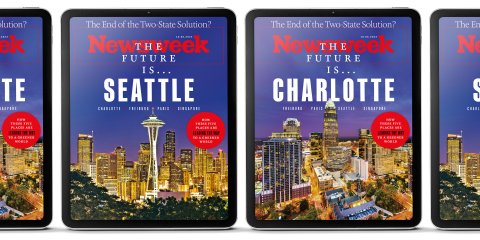
Here is a look at five places that are getting it right in very different ways—from Charlotte, North Carolina's leadership in building a circular economy to Singapore's singular mix of nature and urban design to Paris' determination to shake up the City of Lights and make next year's Olympics a showcase of sustainability. What they have in common is this: All are leading the way toward healthier, environmentally smart futures, through practically achievable actions.
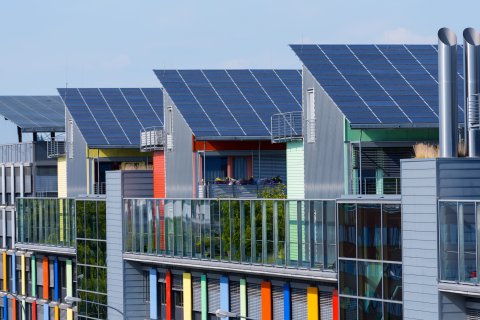
FREIBURG
A city built to be green
Talk about a place that's ahead of its time. The medieval city on the edge of Germany's Black Forest has long been known to climate advocates as a model "eco-city" that has been championing sustainable initiatives since the 1970s. The greening of Freiburg started with a 1974 controversy over plans to build a nuclear power station in the nearby forest. Thousands of protestors camped out at the construction site for nine months and successfully stopped the project, sparking an environmental movement.
In the decades since, Freiburg's leaders and citizens, by careful design, have created a city that incorporates concepts in the vanguard of sustainability into nearly every aspect of daily life. Lots of homes, businesses and public venues powered by solar and other alternative energy sources? Check. A well-thought-out system to reduce waste and reuse what's recyclable? Check. An extensive public transit system and ample bike and pedestrian paths, model green neighborhoods and a thriving eco-tourism and education industry? Check, check and check again.
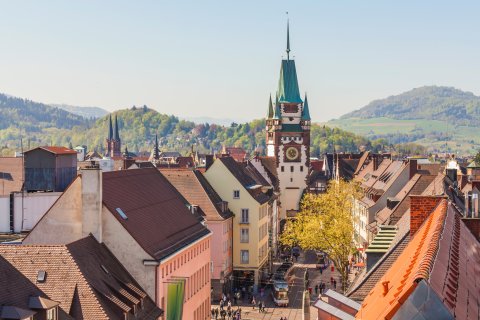
One of the sunniest cities in Germany, Freiburg has gotten a helping hand from nature in leveraging solar power as an energy source for both commercial and residential buildings. Its new city hall, completed in 2017 and boasting 800 solar panels, was designed by its architects to be the world's first "public net-surplus energy building"—that is, to generate more electricity than it consumes. Even its new soccer stadium, built last year, uses a solar roof to generate power.
Freiburg is also famous for its "car-lite" system, restricting the use of cars in several parts of the city. In the planned neighborhood of Vauban, a suburban eco-oasis dotted with colorful homes sporting solar panels and roof gardens, there aren't even any parking spaces; the few residents who own cars have to house them in one of two parking garages on the outskirts of town. There's no problem getting around, though: Freiburg's public tram system connects most neighborhoods to the city center and there are plenty of bicycle lanes and pedestrian paths.
The resulting shift in how people get around has been dramatic. Over the past 40 years, reports German media outlet DW.com, the percentage of drivers in Freiburg has dropped from 39 percent to 21 percent while residents who use bicycles as their main mode of transportation has jumped from 15 percent to one in three.

Freiburg's well-earned reputation as a model green city has given it a thriving eco-tourism industry. Every year, the city welcomes government officials and environmental students from around the world to learn about its sustainable development initiatives and bring that knowledge back to their own countries. Among the cities inspired by Freiburg and duplicating some of its green efforts: Grenoble, Mulhouse and Strasbourg in France; Padua, Italy; and Suncheon in South Korea.
Freiburg's success can be linked back to the democratic strength that stopped the nuclear power plant; today, its citizens are involved with the city's budget planning and are shareholders in local energy sources like solar. While Germany's environmental officials have laid out a roadmap to achieve climate neutrality, or zero greenhouse gas emissions, by 2045, Freiburg's leaders believe the city will hit this goal by 2038.

SEATTLE
An all-hands-on-deck approach
While many officials pay lip service to the urgency of making their cities more sustainable, Seattle's leaders are putting both money and regulatory might into making that pledge a reality. Using a carrot-and-stick approach that combines financial incentives with new laws mandating action, the city is teaming up with local businesses and community groups in a variety of sectors and in a variety of ways to decrease carbon emissions, build a clean energy economy, reduce waste and empower the people most affected by climate change to help devise solutions.
Consider the city's ongoing campaign to reduce waste and plastic pollution. Seattle, which was one of the first major U.S. cities to ban plastic straws in 2018, continued its pioneering ways last year by passing legislation to reduce single-use packaging and ban foam food service ware as well as plastic bags and utensils. To aid the effort, Seattle Public Utilities launched Reuse Seattle, an initiative that helps restaurants, cafes, entertainment venues and other businesses make the switch to reusable packaging via a partnership with reusable cup creator r.Cup, which built a local wash hub, where cups can be cleaned before being delivered for reuse.
Under the program, one of the leading initiatives of its kind in the country, businesses can get rebates of up to $500 to defray the cost of compliance, including the purchase of ceramic mugs to replace plastic cups and tubs to collect dirty dishes as well as services to collect and clean the reusable cups. So far, more than 20 sites, including the Woodland Park Zoo, have eliminated 500,000 single-use cups through the program. Those businesses save money too—an estimated $3,000 to $22,000 a year per business—by not having to constantly restock single-use plastic cups and containers.
Last year, the city also piloted a program to reduce food waste, partnering with three Safeway Albertsons supermarkets to donate edible, unsold food to people in need. The pilot was so successful that 15 other Seattle grocery stores have followed suit, collectively donating around four tons of food a week to food banks rather than throwing it away.
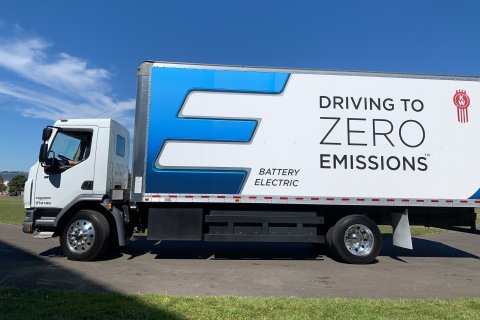
In June the city announced new building emissions standards for larger commercial and multi-family structures that is intended to cut emissions by 27 percent by 2050. And in August, it announced another program to encourage the area's 4,000 diesel drayage trucks—vehicles that pick up goods from cargo ships and transfer them to rail yards and distribution centers and are among the heaviest polluters in the region—to go electric. The program will offer rebates of up to $180,000 per truck. "We hope this pilot can serve as a model for other cities and be scaled up in its efforts to support local truck drivers' transition to electric freight vehicles and improve air quality in neighborhoods where heavy freight activity worsens air pollution," says Kristin Brown, communications manager for Seattle's Office of Sustainability.

Where Seattle really stands out, though, is as a leader in efforts to make environmental initiatives more equitable, inclusive and targeted to communities that are disproportionately affected by climate change, Hong says. As part of a 2019 resolution to create a Green New Deal, the city was the first in the country to establish an oversight board, made up of 19 leaders from diverse communities including tribal members, labor union representatives and young people, to advise on climate matters and ensure a fair transition to a clean energy economy. Based on the board's recommendations, Seattle last year set aside $6.5 million for initiatives such as developing climate "resilience hubs" that provide cooling centers and clean, filtered air to help hard-hit communities deal with extreme heat, wildfire smoke and other climate-related emergencies and expanding the number of city-funded affordable housing units powered by electricity. Another $2.6 million is going toward rebates and no-cost upgrades to help low- and middle-income families switch from oil heat to energy-efficient electric heat pumps.
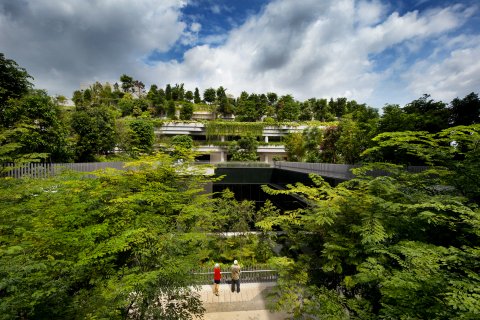
SINGAPORE
An urban jungle reimagined
Climbing sea levels, higher temperatures, intense rainfall, plus a growing population density—Singapore's unique climate challenges demand resilient solutions. For the small island nation, figuring out how to mitigate the impact of climate change, as Prime Minister Lee Hsien Loong once put it, is quite literally a matter of "life and death."
Singapore has risen to the occasion, investing in adaptable urban design using the city's natural environment to make life there more sustainable—and enjoyable. Green spaces are everywhere—parks, rooftop gardens, nature reserves—and strict green building requirements ensure sustainable design principles, especially suited to a tropical climate, are an integral part of both housing and commercial structures.
By restoring natural biodiversity and incorporating native plants into architecture, Singapore "serves as an example for other towns looking to create livable, environmentally conscious cities," says Thomas Schroepfer, professor of architecture and sustainable design at the Singapore University of Technology and Design, and co-director of Singapore-ETH Centre Future Cities Laboratory Global.

Schroepfer says restoring natural ecosystems has big benefits, from pest control to water purification to cleaner air. Bringing back native plants enhances resilience against climate change by removing carbon dioxide from the air—a natural carbon capture. Schroepfer says this, like most of the city's sustainability programs, has been possible through government-funded initiatives, such as Landscape in Urban Spaces and High-Rises (LUSH). Founded in 2017, LUSH provides funding for rooftop gardens and green balconies. Rooftop gardens have climate benefits, like lowering temperature and reducing stormwater runoff, cutting their buildings' energy consumption costs by cooling down the surface temperature.
Along with the climate benefits, the skyrise projects also have social ones, providing therapeutic green space, places to grow food and padding against noise. LUSH has grown in scope each year since its inception, and now also includes things like communal pavilions, planter boxes and solar panels.
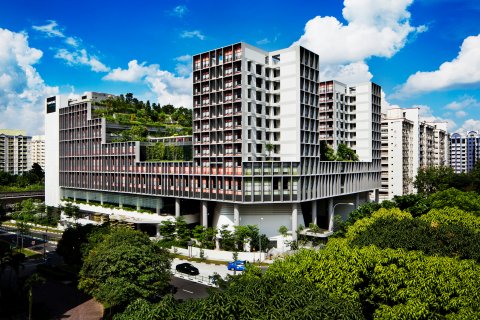
Many of Singapore's sustainability ventures work twofold in this way: mitigating future climate risk while benefiting life for citizens right now. One particular project, which falls under the LUSH program, is The Kampung Admiralty, a senior housing development that opened in 2018. The buildings are outfitted with vertical rain gardens—gardens installed along the walls of buildings—that capture and absorb water runoff. A large park that hosts events like farmers' markets offers residents the chance to socialize with each other and members outside the community; the elder care medical facility was intentionally placed next to a pre-school to promote intergenerational mingling. The project is a product of modern technology combined with local values and even the name is a nod to tradition: Kampung means "village" in Malay.
The most iconic symbol of Singapore's commitment to blending nature with urbanization, though, is its Gardens by the Bay, a 250-acre nature park and sustainable technology showcase in the center of the city. Among its attractions: the Flower Dome, the world's largest glass greenhouse, featuring plants and flowers from five continents; the Cloud Forest, a mist-filled landscape of rare vegetation and dramatic vistas; and Supertree Grove, where 18 soaring tree-like structures are actually vertical gardens fitted with environmental technology that mimics the function of real-life trees, including harnessing solar power for lighting and collecting rainwater for use in irrigation and fountain displays.
Singapore's various sustainability initiatives have since transcended its borders, influencing urban planning efforts around the world. Schroepfer points to the adoption of vertical gardens in Paris, Milan and Vancouver and ecosystem conservation practices in London and Sydney as evidence of the island's ongoing impact on sustainable design.

CHARLOTTE
A circular economy led by small businesses
One of the buzziest concepts in the environmental world these days is the circular economy. Instead of making something, using it, then throwing what's left of it away—the old linear economy—the idea is to keep products and materials in circulation for as long as possible through means like maintenance, recycling, reuse, repurposing and composting. It's a way, proponents say, to reduce waste, pollution and greenhouse gas emissions from landfills while creating jobs and boosting the local economy.
Several years ago, Charlotte, North Carolina set out to become a U.S. leader in the circular economy, after a report found that 88 percent of the city's 900,000 tons of annual waste ended up in landfills. If just 15 percent of that waste was recycled instead, the analysis found, Charlotte could generate $34 million in revenue and create nearly 500 jobs, in addition to the positive impact on tackling climate change.
Enter The Innovation Barn, a joint project between the city and an organization called Envision Charlotte that is ground zero in Charlotte's circular economy plan.
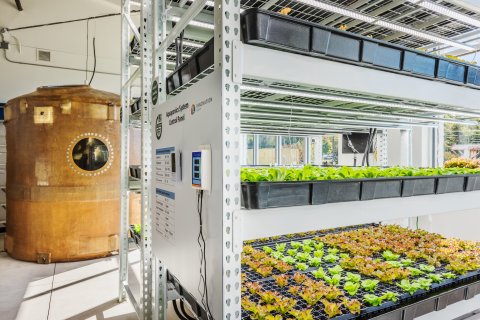
Opening to the public two years ago, the Barn is an ecosystem of local businesses banding together to make each other's practices, and the city at large, more sustainable. Housed in a 26,000-square-foot former horse barn that Envision Charlotte rents from the city for $1 a year, the Barn contains multiple retail shops; a teaching kitchen that holds classes on reducing food waste; a composting lab and an aquaponics garden that produces leafy green vegetables and raises tilapia using cutting edge technology, among other ventures. It also runs programming and events like farmer's markets, all dedicated to sharing, reusing, repairing and recycling materials and products.

Key to the Innovation Barn's success is the interconnectedness of the various enterprises located there. Crown Town Compost, for example, takes unused food scraps sourced from its neighbor The Bulb, a nonprofit that salvages surplus from stores like Trader Joe's and Food Lion for donation to neighborhoods struggling with food scarcity. Rather than tossing the waste, Crown Town Compost runs a pilot program breaking it down using black soldier fly larvae, which, according to the company "act as nature's garbage disposals," converting it into soil for local gardens.
Another initiative at the Innovation Barn is spearheaded by Charlotte's thriving craft brewery industry. Ten breweries, along with Trader Joe's stores and members of the public, recycle their plastic beverage carriers into shredded material that can be put towards producing building materials (the Barn's benches are made from them). Since March 2022, more than 36,000 carriers have been collected—a little over half a ton. This year, the Barn also began recycling the grain bags that breweries use to make beer, making them into shopping bags.
The Innovation Barn houses social enterprises, too, like Change Please, a nonprofit coffee shop that employs people who are homeless as baristas. All of the shop's proceeds are funneled to its employees, in the form of wages, transportation, housing, therapy or helping them find other job opportunities.
Along with community events, the Barn offers tours to the public, providing a visual representation of what circularity really means and ways of cultivating it in individual lives. Amy Aussieker, executive director of Envision Charlotte, says, "I would argue that our most profound impact is the heightened awareness and education on the circular economy that we've cultivated within the Charlotte community."
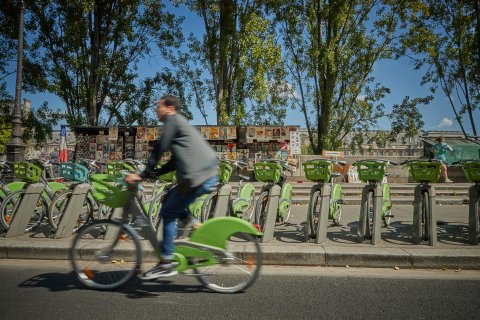
PARIS
The 15-minute city
The City of Lights is known for a lot of things: romance, for one; cultural landmarks like the Eiffel Tower, the Louvre and the Champs-Élysées, for another; rich history, traditions, food and fashion, surely; and a certain snobbery about people who don't speak French, particularly if they're camera-toting American tourists. What probably doesn't leap to mind when you think about Paris is a city on the cutting edge of climate change solutions, particularly when it comes to something as seemingly mundane as transportation infrastructure.

Yet that's precisely the area in which Paris has been establishing itself as a world leader recently. Under the leadership of Mayor Anne Hidalgo, who has made environmental policy a priority since she was first elected in 2014, the city is lightening up on cars, expanding alternate ways of getting around and generally going a lot greener, including in the literal sense by adding parks, trees and gardens where concrete used to be.
Changing the way Parisians get from one place to another is at the heart of the city's sustainability transformation. Often praised for its train system, Paris is taking public transit to the next level by limiting motor vehicles and expanding bike paths through a $267 million plan announced in 2021. Hidalgo has closed the streets outside of schools to traffic, and approved plans for a pedestrian-friendly renovation of the Champs-Élysées. The makeover will reduce the number of car lanes from four to two, create new, wider walkways and turn the 1.2-mile road into a lush promenade with tunnels of trees and new terrace spaces.
In 2024—the year Paris hosts the Olympic games—a car-free zone will be implemented in much of the city center; the goal is to cut traffic by at least half. Paris is also phasing out gas- and diesel-powered cars and offering grants to Parisians who stop using old vehicles, with the goal of moving to solely electric ones by 2030.
"Paris is leading when it comes to innovative sustainability projects being implemented right now," says architect Jorge Pérez Jaramillo, who was the planning director for the city of Medellín from 2012 to 2015, citing its introduction of the 15-minute city concept. The term, coined by urbanist and associate professor at Panthéon-Sorbonne University, Carlos Moreno, refers to a place where all the basic necessities and services people need to live, from healthcare to groceries to parks and cultural centers, are within a 15-minute walk, bike ride or public transit trip from residents' front doors. The model promotes walking and builds community in neighborhoods, while reducing car dependency.

The city is also working on updating its infrastructure, without destroying the historical buildings that give Paris its charm. La REcyclerie, for example, is an eco-center in an old train station that's home to an urban farm, locally sourced, seasonal prepared foods and workshops on recycling practices. La Cité Fertile is a converted freight station that houses a brewery and greenhouse, and in the summer organizes environmental and political forums. Even the most iconic structures are getting a greener look, with new park areas being built around the Eiffel Tower and the Place de la Concorde, the city's largest square, in time for the start of the Olympics next year.
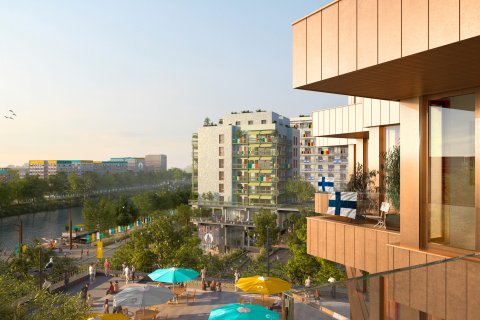
The Games themselves will be another opportunity for Paris to showcase its commitment to sustainability, with the city promising to halve the carbon footprint compared to 2012 and 2016. Toward that end, the city has minimized new construction; 95 percent of the venues will be pre-existing buildings or temporary structures—including events to be held at the Eiffel Tower among other historic locations—and all will be powered with 100 percent renewable electricity generated by wind or solar power.
"Environmental and climate responsibility was a condition of our bid and it is a central aspect of our project," says Georgina Grenon, the Olympics' director of environmental excellence. "[We are] building less but building better, and making the most of our country's heritage."
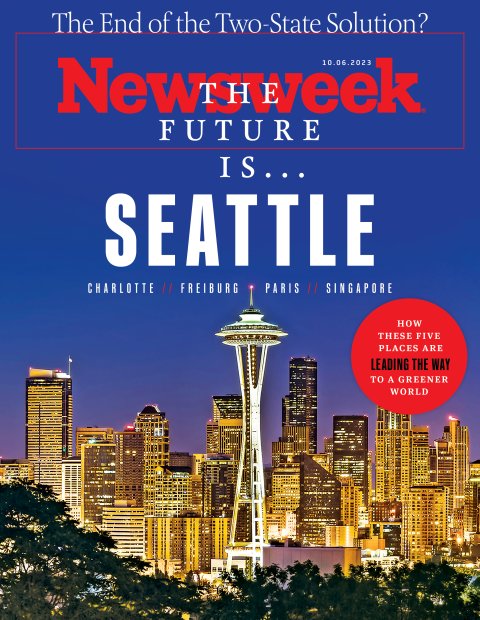

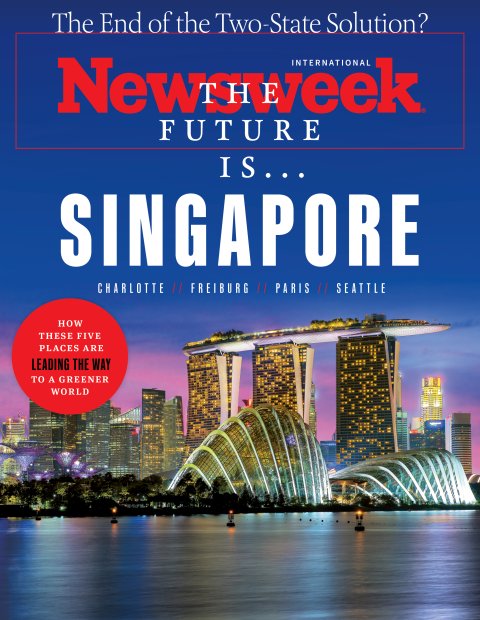
About the writer
To read how Newsweek uses AI as a newsroom tool, Click here.





